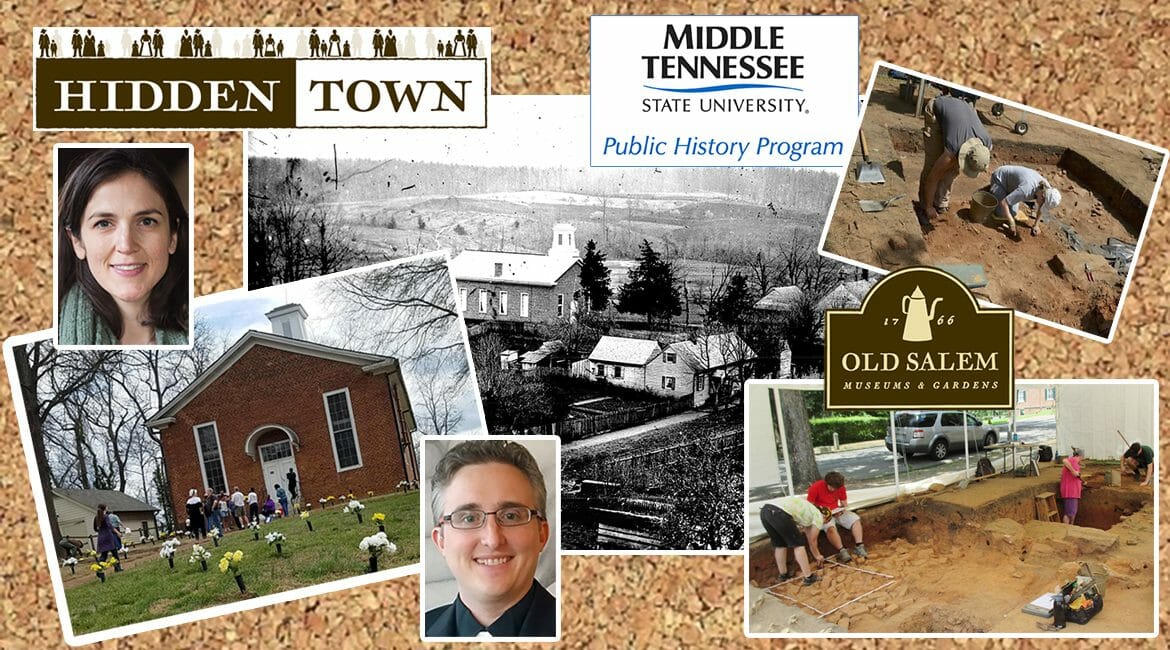MTSU students will combine old-fashioned information gathering and new technology to bring an historical site closer to the public.
The Digital History Program’s “Maymester Experience” will team Dr. Molly Taylor-Poleskey’s digital history class with Department of Media Arts’ professor Richard Lewis’ motion graphics class to create “Hidden Town in 3D.”

Dr. Molly Taylor-Poleskey

Taylor-Poleskey’s students are now in the Moravian village of Old Salem in Winston-Salem, North Carolina, where they’ll create three-dimensional models of the historic townscape.
Eight public history doctoral students will stay through May 31 to gather data about African-American dwellings that existed in the 19th and early 20th centuries within a village of European Moravians from Germany.
The Moravians, who migrated from a part of what was 19th-century Germany that is now in the Czech Republic, adhered to Protestant principles espoused by Jan Hus, a theologian who was executed in 1415 for having religious views similar to those Martin Luther espoused some 50 years later.
Seeking religious freedom, some Moravians fled to England, Pennsylvania and North Carolina. Taylor-Poleskey said Moravians were unique among other radical Protestant sects because African-Americans lived among them. There was even some intermarriage.

This photograph depicts the 1861 brick structure of St. Philips Moravian Church standing tall in the village of Old Salem in Winston-Salem, North Carolina, and several other buildings on Church Street. The original 1823 log church is shown at far right. St. Philips is one of the oldest black congregations in the United States and the only historic African-American Moravian congregation in the country. MTSU history and animation students will be working together this summer to bring the 19th-century site back to 3D life. (Photo courtesy of the Old Salem Museum and Gardens)
“Early on, a small number of African-Americans were part of the Moravian community in all levels, including religious,” said Taylor-Poleskey, who teaches in MTSU’s Department of History. “They worshipped side by side with the white Moravians.”
The Moravians, however, were highly mission-oriented religious people who also justified slavery as a means to advancing their missionary goals. By the 1840s, the immigrants had become more Southern and less adherent to the rules of their faith. Racial differences gradually became more important than the common faith with their neighbors.

Richard Lewis
 Archaeological excavations in the last two decades have uncovered evidence of many African-American lives in Salem. With the information Taylor-Poleskey’s students obtain on-site, they will create a virtual exhibit accessible on the web and a packet for Lewis.
Archaeological excavations in the last two decades have uncovered evidence of many African-American lives in Salem. With the information Taylor-Poleskey’s students obtain on-site, they will create a virtual exhibit accessible on the web and a packet for Lewis.
His students will spend the summer creating a digital rendering of a former African-American dwelling that will be inserted into a virtual reality experience showing the buildings where they once were on the landscape and information about them.
The professors said they hope to have the entire project online by the end of summer.
“We’re doing something groundbreaking,” Taylor-Poleskey said. “We are creating the process. It’s not just playing with some fun toys and doing a digital project. We’re pushing the bounds of museum interpretation.”3323
For more information, contact Taylor-Poleskey at molly.taylor-poleskey@mtsu.edu or Lewis at richard.lewis@mtsu.edu.
— Gina K. Logue (gina.logue@mtsu.edu)

A crew excavates an historic site in the Moravian village of Old Salem in Winston-Salem, North Carolina, where MTSU history and animation students will be working together this summer to bring the 19th-century site back to 3D life. (Photo courtesy of the Old Salem Museum and Gardens)

Visitors gather outside St. Philips Moravian Brick Church in the village of Old Salem in Winston-Salem, North Carolina, to prepare for the African-American Heritage Tour that traces the history of one of the oldest black congregations in the United States. The flowers mark the burial places revealed by archaeological excavations of Salem’s original Strangers’ Graveyard and the graveyard used for enslaved African-Americans after their white Moravian neighbors embraced racial segregation. (Photo courtesy of the Old Salem Museum and Gardens)

St. Philips Moravian Brick Church in the village of Old Salem in Winston-Salem, North Carolina, sits on a rise behind the original log church where the St. Philips Moravian congregation worshiped from 1823 until 1861, when the brick structure was finished. The brick church was used until 1952, and the congregation has worshiped since 1967 in its newer home in Winston-Salem, returning to the restored old brick church for fifth-Sunday and other special services. St. Philips is one of the oldest black congregations in the United States and the only historic African-American Moravian congregation in the country. (Photo courtesy of the Old Salem Museum and Gardens)


COMMENTS ARE OFF THIS POST